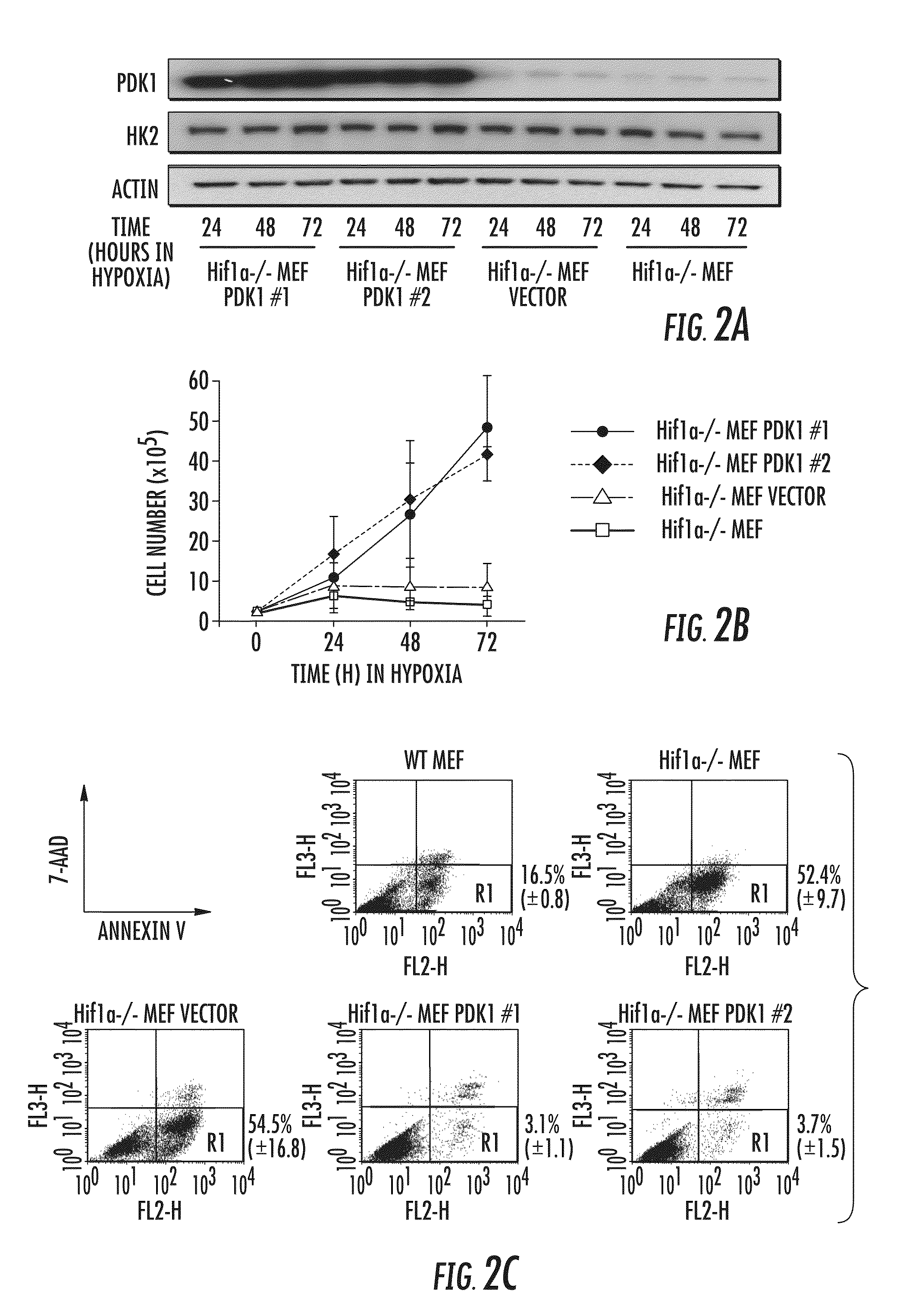Pyruvate dehyrogenase kinases as theraeutic targets for cancer and ischemic diseases
a technology of pyruvate dehyrogenase and kinases, which is applied in the direction of dna/rna fragmentation, biological material analysis, enzymes, etc., can solve the problems of focal or global brain damage, reduced oxygen availability, and impaired normal cellular metabolism, so as to reduce cell death, reduce the expression of pdh nucleic acid molecule, and reduce cell death
- Summary
- Abstract
- Description
- Claims
- Application Information
AI Technical Summary
Benefits of technology
Problems solved by technology
Method used
Image
Examples
example 1
PDK1 is Highly Induced by Hypoxia and is Responsive to MYC
[0235]Microarray analysis was used to characterize gene expression in the human B lymphocyte cell line, P493-6, which contains a tetracycline-repressible MYC allele4,5. This analysis identified genes responsive to both MYC and hypoxia. PDK1 was identified as one gene that is highly induced by hypoxia. PDK1 was previously shown to be a potential MYC target6. Because of PDK1's involvement in the regulation of glucose metabolism by the TCA cycle, it was selected for further analysis. Hypoxic induction of PDK1 protein expression was demonstrated by immunoblot assay (FIG. 1A).
[0236]HIF-1 is a heterodimeric transcription factor, consisting of HIF-1α and HIF-1α subunits, which functions as a master regulator of oxygen homeostasis in all metazoan species7,8. PDK1 levels were also increased in P493-6 cells exposed to CoCl2 (FIG. 1B), which induces HIF-1 activity by inhibiting O2-dependent degradation of the HIF-1α subunit9,10. To dete...
example 2
PDK1 Inhibits the Hypoxic Cell Death of HIF-1α-Null MEFs
[0238]To determine whether active suppression of the TCA cycle and stimulation of glycolysis via inactivation of PDH by PDK1 is required for cell survival under hypoxic conditions, Hif1a− / − cell pools with forced overexpression of PDK1 by independent retroviral infections were generated (FIG. 2A). This overexpression resulted in increased PDH E1α subunit phosphorylation, which was also observed in hypoxic wild-type mouse embryo fibroblasts (FIGS. 2D and 2E). Intriguingly, forced PDK1 expression was sufficient to permit the proliferation of hypoxic Hif1a− / − mouse embryo fibroblasts (FIG. 2B) and to protect them from hypoxia-induced apoptosis (FIG. 2C). In contrast, forced expression of the murine glycolytic enzyme glucose phosphate isomerase (mGPI) could not rescue hypoxic Hif1a− / − mouse embryo fibroblasts (FIGS. 2F and 2G).
example 3
HIF-1-Induced PDK1 Activity Reduces ROS Production
[0239]The observation that PDK1 rescued hypoxic HIF-1α-null mouse embryo fibroblasts suggested that PDK1-mediated inactivation of the PDH complex; that PDK1 shunted pyruvate away from the TCA cycle toward glycolysis; and that these activities were sufficient for the survival of hypoxic cells. Limited O2 availability may lead to increased ROS production due to ineffective electron transfer in the mitochondria if flux through the TCA cycle is not attenuated14,15. Increased ROS levels would, in turn, trigger apoptosis14. As shown in FIG. 3A, hypoxia caused an increase in intracellular H2O2 in Hif1a− / − mouse embryo fibroblasts in sharp contrast to the reduction in H2O2 levels that was observed when wild type mouse embryo fibroblasts were exposed to hypoxia. These data, taken together with the demonstration that forced PDK1 expression prevented hypoxia-induced apoptosis of Hif1a− / − mouse embryo fibroblasts suggested that HIF-1-induced PDK...
PUM
| Property | Measurement | Unit |
|---|---|---|
| molecular weight | aaaaa | aaaaa |
| molecular weight | aaaaa | aaaaa |
| molecular weight | aaaaa | aaaaa |
Abstract
Description
Claims
Application Information
 Login to View More
Login to View More - R&D
- Intellectual Property
- Life Sciences
- Materials
- Tech Scout
- Unparalleled Data Quality
- Higher Quality Content
- 60% Fewer Hallucinations
Browse by: Latest US Patents, China's latest patents, Technical Efficacy Thesaurus, Application Domain, Technology Topic, Popular Technical Reports.
© 2025 PatSnap. All rights reserved.Legal|Privacy policy|Modern Slavery Act Transparency Statement|Sitemap|About US| Contact US: help@patsnap.com



